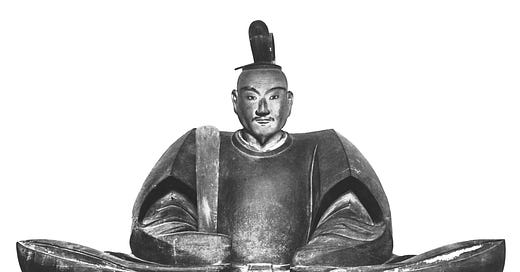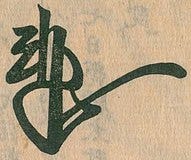Ashikaga Yoshizumi was born January 15, 1481, the grandson of the sixth Shogun, Ashikaga Yoshinori, and was the second son of Ashikaga Masatomo, the Kanto Kubo, (a title equivalent to Shogun of the Eastern Provinces). Yoshizumi was chosen to be heir over his elder brother, Chacha-maru, who then revolted, assassinating his father in 1491, and clamed his inheritance.
Chacha-maru in turn would be deposed by Hojo Soun, one of the major powers of the Sengoku period two years later, however in the interim, Yoshizumi was forced to seek refuge with Imagawa Ujichika in Suruga (Shizuoka Pref.). The Imagawa, a cadet branch of the Ashikaga clan, brought Yoshizumi to Kyoto and to the attention of Deputy Shogun, Hosokawa Masamoto. Yoshizumi was later adopted by the eighth Shogun, Ashikaga Yoshimasa.
In March 1489, Yoshizumi’s cousin, the 9th shogun, Ashikaga Yoshihisa, died and Yoshimasa lost his successor. Yoshimasa died heirless the following year and so the position of Muromachi Shogun became vacant. Yoshizumi was seen as a successor candidate, however Ashikaga Yoshiki (later known as Yoshitane), another cousin, was appointed as the tenth shogun on the recommendation of Yoshihisa's widow, Hino Tomiko. Tomiko also decided to hand over the Ogawadono Palace, where she lived with the late Yoshihisa, to Yoshizumi. When this was announced in April, 1490,Yoshiki's father, Yoshimi, suspected that Tomiko was preparing to make Yoshizumi the next shogun, and so he ordered the fiery destruction of Ogawadono Palace the following month. This act led to deterioration of the relationship between Yoshiki and Tomiko.
From that time on Yoshizumi was supported by Kanrei Hosokawa Masamoto, Hino Tomiko, and Ise Sadamune, who banished Yoshiki in the Meio Coup in April 1493, and came to be regarded as the adopted son of the late Yoshimasa and was thus appointed Shogun.as the However, real political and military power was held by his supporters, Masamoto, Tomiko, Sadamune and others. On December 27, 1494, the coming-of-age ceremony was held just before the proclamation of ShogunIn 1493, his cousin, the 10th shogun Ashikaga Yoshiki (aka Yoshitane), was exiled by Hosokawa Masamoto, and in turn, Yoshizumi was appointed as the 11th shogun. In 1494, his investiture as the 11th Shogun was orchestrated by deputy Shogun, Hosokawa Masamoto, who had ousted Yoshimasa’s cousin, tenth Shogun Ashikaga Yoshitane (aka Yoshiki). However Yoshizumi would be stripped of his position 14 years later by Yoshitane, who raised an army against Kyoto and by ousting his 30-year-old cousin, was then restored to power.
Yoshizumi served from January 23, 1495, to May 15, 1508 (Gregorian Calendar). After Tomiko’s death on June 30, 1496 Yoshizumi attempted to manage government affairs himself, coming into conflict with Hosokawa Masamoto. In response to Masamoto and Ise Sadamune, Yoshizumi demanded the appointment of Takeda Motonobu as a companion and the execution of Yoshitada's half-brother by a different mother. Hosokawa Masamoto agreed to this. However, with Yoshitada’s brothers’s slaying, Masamoto lost a potential candidate for the role of shogun to replace Yoshizumi, making it impossible for him to dispose of Yoshizumi, and so for a while Yoshizumi and Masamoto continued to maintain a cooperative relationship despite being politically opposed.
Masamoto was assassinated in 1507, causing internal discord over the Hosokawa clan headship. Then in 1508, Ouchi Yoshioki, who supported the former shogun Yoshitane, raised an army to march on Kyoto, and in the turmoil Yoshizumi was forced to flee, taking refuge in Omi Province (Shiga Prefecture). He called on Rokkaku Takayori in Omi Province and escaped to Kutsukidani, and further to Mizuki, Okayama Castle in Gamo County. In July, Yoshizumi was dismissed from the position of shogun and Yoshitada returned to the position of shogun.
In an attempt to regain power, Yoshizumi ordered Hosokawa Sumimoto, Miyoshi Yukinaga, and his son Nagahide to invade Kyoto, but each time they were defeated by Hosokawa Takakuni, Ouchi Yoshioki, Hatakeyama Naojun, and others. An assassination attempt on Shogun Yoshitada also failed. In 1510, Yoshizumi’s faction was attacked by Hosokawa Takakuni and Ouchi Yoshioki, on the orders of Shogun Yoshitada. The Shogun’s troops invaded Omi Province, but Yoshizumi, backed by an army including supporters Hosokawa Sumimoto, Miyoshi Yukinaga, Akamatsu Yoshimura and Omi locals, won the battle.
However, on September 6, 1511, just before the Battle of Funaokayama against Shogun Ashikaga Yoshitada, Hosokawa Takakuni, and Ouchi Yoshioki, Yoshizumi died of illness at Mizuki Okayama Castle, aged around 32.
On September 15, nine days after Yoshizumi's death, the Battle of Funaoka broke out. Hosokawa Sumimoto, Miyoshi Yukinaga, and Akamatsu Yoshimura were defeated, and Yoshitada's position as shogun was confirmed. The two camps would later reconcile, and Yoshizumi's sons, Yoshiharu and Yoshitsuna, supported by Akamatsu Yoshimura and Hosokawa Yukimochi (Sumimoto's elder brother), respectively, became the 12th and 14th Shogun.
While Yoshizumi’s actual is gravesite is unknown, there is a five-tiered pagoda in Oshuku, Ashigawa-cho, Fuefuki City, Yamanashi Prefecture, which is said to be Yoshizumi's grave. Despite his political and historical importance, there are no reliable contemporary portraits of him, but wooden statues of the former Shogun can be found in Kyoto’s Toji-in Temple and Ban'a-ji Temple.







Agreed, Too many Yoshi's, and the habit of changing names gets confusing when translating information too.
Too many Yoshis 😄